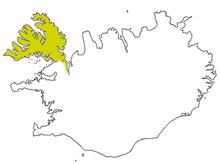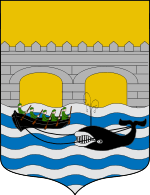Basque–Icelandic pidgin
| Basque–Icelandic pidgin | |
|---|---|
| Region | Iceland, Atlantic |
| Era | 17th century |
|
Basque-based pidgin | |
| Language codes | |
| ISO 639-3 |
None (mis) |
| Glottolog |
icel1248 Icelandic–Basque Pidgin[1]basq1251 Basque Nautical Pidgin[2] |
 Westfjords, the Icelandic region that produced the manuscript containing the Basque–Icelandic pidgin | |
The Basque–Icelandic pidgin was a pidgin spoken in Iceland in the 17th century. It is preserved in Icelandic manuscripts from the same and the following century. The pidgin consisted of Basque, Germanic and Romance words. It might have developed in Westfjords, where the manuscripts were written, but since it had influences from many other European languages, it is more likely that it was created elsewhere and brought to Iceland by Basque sailors.[3]
In the manuscript AM 987 4to, kept at the Árni Magnússon Institute for Icelandic Studies in Reykjavík, there are two Basque–Icelandic glossaries called Vocabula Gallica ('French words') and Vocabula Biscaica ('Biscayan words'). Towards the end of Vocabula Biscaica, which contains a total of 278 words and short sentences, there are a few phrases where the Basque entries are mixed with words from Dutch, English, French, German and Spanish. The Basque–Icelandic pidgin is thereby not a mixture between Basque and Icelandic, but between Basque and other languages. It was named from the fact that it was written down in Iceland and translated into Icelandic.[4]
Pidgin entries in Vocabula Biscaica
| Word number | Basque glossary | Modern Basque | Icelandic glossary | English translation |
|---|---|---|---|---|
| 193 & 225 | presenta for mi | Emadazu | giefdu mier | Give me |
| 196 | bocata for mi attora | Garbitu iezadazu atorra | þvodu fyrer mig skyrtu | Wash a shirt for me |
| 209 | fenicha for ju | Izorra hadi! | liggia þig | Fuck you![5] |
| 216 | presenta for mi locaria | Emazkidazu lokarriak | giefdu mier socka bond | Give me garters |
| 217 | ser ju presenta for mi | Zer emango didazu? | hvad gefur þu mier | What do you give me? |
| 218 | for mi presenta for ju biskusa eta sagarduna | Bizkotxa eta sagardoa emango dizkizut | Eg skal gefa þier braudkoku og Syrdryck | I will give you a biscuit and a sour drink |
| 219 | trucka cammisola | Jertse bat erosi | kaufftu peisu | Buy a sweater |
| 220 | sumbatt galsardia for | Zenbat galtzerditarako? | fyrer hvad marga socka | For how many socks? |
| 223 | Cavinit trucka for mi | Ez dut ezer erosiko | eckert kaupe eg | I buy nothing |
| 224 | Christ Maria presenta for mi Balia, for mi, presenta for ju bustana | Kristok eta Mariak balea ematen badidate, buztana emango dizut | gefe Christur og Maria mier hval, skal jeg gefa þier spordenn | If Christ and Mary give me a whale, I will give you the tail |
| 226 | for ju mala gissuna | Gizon gaiztoa zara | þu ert vondur madur | You are an evil man |
| 227 | presenta for mi berrua usnia eta berria bura | Emadazu esne beroa eta gurin berria | gefdu mier heita miölk og nyt smior | Give me hot milk and new butter |
| 228 | ser travala for ju | Zertan egiten duzu lan? | hvad giorer þu | What do you do? |
The word numbers are the same as in AM 987 4to. The manuscript's Basque and Icelandic phrases are from Deen (1937:102-105). The modern Basque entries are from Basque Wikipedia and French Wikipedia. The English translations are based on the Icelandic text, which differs in some places from the Basque equivalents in the glossaries. For example, sagarduna 'cider' is not synonymous with Syrdryck 'sour drink'.
Words of Basque origin
- atorra, atorra 'shirt'
- balia, balea 'baleen whale'
- berria, berria 'new'
- berrua, beroa 'warm'
- biskusa, (Lapurdian) loan word bizkoxa 'biscuit', nowadays meaning gâteau Basque (cf. Spanish bizcocho, ultimately from Old French bescuit)
- bocata[6]
- bustana, buztana 'tail'
- eta, eta 'and'
- galsardia, galtzerdia 'the sock'
- gissuna, gizona 'the man'
- locaria, lokarria 'the tie/lace(s)'
- sagarduna, sagardoa 'the cider'
- ser, zer 'what'
- sumbatt, zenbat 'how many'
- travala, old Basque trabaillatu, related to French travailler and Spanish trabajar 'to work'
- usnia, esnea 'the milk'
- bura, 'butter', from Basque Lapurdian loan word burra[7] (cf. French beurre, Italian burro and Occitan burre)
Words of Germanic origin
- cavinit, old Dutch equivalent of modern German gar nichts 'nothing at all'[8] or Low German kein bit niet 'not a bit'[9]
- for in the sentence sumbatt galsardia for could be derived from many different Germanic languages[10]
- for mi, English 'for me' (used both as subject and object; 'I' and 'me')
- for ju, English 'for you' (used both as subject and object)
Words of Romance origin
- cammisola, Spanish camisola 'shirt'
- fenicha, Spanish fornicar 'to fornicate'
- mala, French or Spanish mal 'bad' or 'evil'
- trucka, Spanish trocar 'to exchange'[11]
There are also many other French and Spanish words in the rest of Vocabula Biscaica and the other Basque-Icelandic glossaries. For example, Basque eliza 'church' in the beginning of the glossary is related to French église and Spanish iglesia. However, this is no sign of the pidgin language, but rather a result of French and Spanish influence on the Basque language throughout the ages, since Basque has taken many loan words from its neighbouring languages.[9] Furthermore, many of the people in the Basque crews that came to Iceland might have been multilingual, speaking French and/or Spanish as well. That would explain for example why the Icelandic ja 'yes' is translated with both Basque bai and French vÿ (modern spelling oui) at the end of Vocabula Biscaica.[12]
History of the glossaries
The copy of Vocabula Biscaica which is preserved was written by Jón Ólafsson from Grunnavík, who copied an older but now lost original. This copy was found, together with Vocabula Gallica, in the mid-1920s by the Icelandic philologist Jón Helgason in the Arnamagnæan Collection at the University of Copenhagen. He copied the glossaries, translated the Icelandic words into German and sent the copies to professor Christianus Cornelius Uhlenbeck at Leiden University in the Netherlands. Uhlenbeck had expertise in Basque, but since he retired from the university in 1926, he gave the glossaries to his post-graduate student Nicolaas Gerard Hendrik Deen. Deen consulted with the Basque scholar Julio de Urquijo, and in 1937, he published his doctoral thesis on the Basque-Icelandic glossaries. It was called Glossaria duo vasco-islandica and written in Latin, though most of the phrases of the glossaries were also translated into German and Spanish.[3] In 1986 the original manuscript was brought back from Denmark to Iceland.[13]
There is also evidence of a third contemporary Basque-Icelandic glossary. In a letter, the Icelandic linguist Sveinbjörn Egilsson mentioned a document with two pages containing "funny words and glosses"[8] and he copied eleven examples of them. The glossary itself has been lost, but the letter is still preserved at the National Library of Iceland. However, there is no pidgin element in this glossary[3]
Recently, a fourth Basque-Icelandic glossary has been found at the Houghton Library at Harvard University.[14]
See also
References
- ↑ Hammarström, Harald; Forkel, Robert; Haspelmath, Martin, eds. (2017). "Icelandic–Basque Pidgin". Glottolog 3.0. Jena, Germany: Max Planck Institute for the Science of Human History.
- ↑ Hammarström, Harald; Forkel, Robert; Haspelmath, Martin, eds. (2017). "Basque Nautical Pidgin". Glottolog 3.0. Jena, Germany: Max Planck Institute for the Science of Human History.
- 1 2 3 Guðmundsson, Helgi (1979). Um þrjú basknesk-íslenzk orðasöfn frá 17. öld. Reykjavík: Íslenskt mál og almenn málfræði.
- ↑ Bakker, Peter; Bilbao, Gidor; Deen, Nicolaas Gerard Hendrik; Hualde, Jose Ignacio (1991). "Basque Pidgins in Iceland and Canada". Colección Miscelánea. 23. San Sebastian, Spain: Diputación Foral de Gipuzkoa.
- ↑ The phrases fenicha for ju - liggia þig were among the few entries in the glossaries that Deen did not translate to German or Spanish in his doctoral thesis. Instead he wrote cum te coire 'make love to you' in Latin (Deen 1938:103). However, Miglio (2008:10) means that the phrase rather should be understood as an insult.
- ↑ Deen (1937:102) suggests that bocata is bokhetatu with the Spanish translation colar 'sieve', 'percolate' or 'pass'. The Icelandic equivalent is þvodu 'wash!'.
- ↑ The loan word burra is documented in the Northern Basque Country Basque-language written tradition since the mid-17th century. Source: Mitxelena, Koldo (2005). Orotariko Euskal Hiztegia. Euskaltzaindia. Retrieved 23 October 2012.
- 1 2 Miglio, Violia Giulia (2008). ""Go shag a horse!": The 17th-18th century Basque-Icelandic Glossaries Revisited" (PDF). Retrieved 2012-05-13.
- 1 2 Hualde, José Ignacio (2009). Basque Words. Tinta. Archived from the original on 2016-03-04. Retrieved 2012-05-13.
- ↑ Deen (1937:104).
- ↑ Deen (1937:103). Could also be derived from Basque trukea 'the exchange'
- ↑ (Deen 1937:101) and Miglio (2006:200).
- ↑ Knörr, Henrike (2007). "Basque Fishermen in Iceland Bilingual vocabularies in the 17th and 18th centuries". Archived from the original on 2012-05-01. Retrieved 2012-05-13.
- ↑ Belluzzo, Nicholas (2007). "Viola Miglio and Ricardo Etxepare - "A new Basque - Icelandic glossary of the 17th century."". Archived from the original on 2012-05-05. Retrieved 2012-05-13.
Bibliography
- Bakker, Peter (1987): "A Basque Nautical Pidgin: A Missing Link in the History of fu", Journal of Pidgin and Creole Languages 2:1, pp. 1–30.
- Bakker, Peter, et alii. (1991): Basque pidgins in Iceland and Canada. Anejos del Anuario del Seminario de Filología Vasca "Julio de Urquijo", XXIII.
- Deen, Nicolaas Gerard Hendrik (1937): Glossaria duo vasco-islandica, Amsterdam; (doctoral dissertation re-printed in 1991 in Anuario del Seminario de Filología Vasca Julio de Urquijo Vol. 25, Nº. 2, pp. 321–426).
- Guðmundsson, Helgi (1979): "Um þrjú basknesk-íslenzk orðasöfn frá 17. öld" in Íslenskt mál og almenn málfræði 1, pp. 75–87.
- Holm, John A. (1989): Pidgins and Creoles. vol. 2 Reference Survey, "Cambridge Languages Surveys", pp. 628–630.
- Hualde, José Ignacio (1984): "Icelandic Basque pidgin", Journal of Basque Studies in America 5, pp. 41–59
- Hualde, José Ignacio (2009): Basque Words.
- Miglio, Viola Giulia (2008): "Go shag a horse!": The 17th-18th century Basque-Icelandic glossaries revisited Journal of the North Atlantic, vol. I, 25-36.
- Yraola, Aitor (1983): "Um baskneska fiskimenn á Norður-Atlantshafi" Saga 21, pp. 27–38.

